|
|
|
|
|
|
|
|
|
|
|
|
|
|
|
| |
|
|
| JUDICIAL |
Current Key Cases |
Milestone decisions establishing whole trends in Everglades development
are made by courts - at Federal and State levels |
 |
Judge F.A. MORENO
(earlier - Judge Hoeveler)
Consent Decree
The US District Court,
Southern District of Florida.
Case #88-1886-civ-Moreno:
USA vs. South Florida Water Management District.
.
|
The 1991 Settlement Agreement, entered as Consent Decree by Judge Hoeveler in 1992, 847 F. Supp 1567 (S.D. Fla 1992) sets out in detail the steps the State of Florida would take over the next ten years to restore and preserve water quality in the Everglades. Judge Moreno appointed the
Special Master (John M. Barkett) to determine if the water quality standards in the Everglades National Park and the Loxahatchee National Wildlife Refuge were met. During the last 9 months, there were 3 hearings:
(1) Aug. 31, 2010: concerned the construction of a deep reservoir on the Talisman properties (A1) in the Everglades Agricultural Area (EAA).
(2) Oct. 25, 2010: dealt with broader issues related to Loxahatchee water quality violation that occurred on June 2009 and whether the SFWMD used inappropriate data in calculating discharges to ENP during Water Year 2008 to conform with the discharge limits for the water year. Other issues related to the inadequate source controls implemented in the western basin were also addressed.
(3) Feb. 14-17, 2011: discussed the remedies for 2 Loxahatchee phosphorus exceedence “excursions” that occurred in 2008 and 2009.
STA-1E design and operation problems were also discussed.
It was also obvious through the discussion that the Gold and Moreno cases are intertwined. Both cases are dealing with the main issues at hand: 1) how to reach the 10 ppbP long term geometric mean in the marsh of the Everglades Protection Area (EvPA), and 2) how to determine the Water Quality Based Effluent Limits (WQBEL) for the STAs discharging into the EvPA. During the Consent Decree hearing, all the agencies were already discussing issues related to the Gold case (see below).
The Technical Oversight Committe (TOC-SFWMD) coordinates the compliance with the Consent Decree (see Calendar for meetings - March 1, 2011- and quarterly ) |

|
Judge Alan S. GOLD
Case #1:04-cv-21448-ASG
Miccosukee Tribe of Indians and Friends of the Everglades vs. USA et al.
(Lead case #04-21448-cv-Gold consolidated with #04-cv-22072, and #05-cv-20663).
The US District Court, Southern District of Florida.
|
In July 2008 Judge Gold had entered an Order finding that EPA violated its duties under the Clean Water Act.
In the April 2010 Order, Judge Gold ordered EPA to craft an enforceable plan with Florida to cut phosphorus levels and if the Florida State does not do so, ordered EPA to draft such a plan itself.
Judge Gold required EPA and FDEP to develop and meet specific water quality milestones with an enforceable framework:
(1) - by 9/3/10 EPA must draft an Amended Determination directing the State to correct the deficiencies of the Amended Everglades Forever Act.
(2) - by 11/3/10 EPA shall conform all NPDES permits for Stormwater Treatment Areas (STAs).
(3) - b
y 7/1/ 2011 EPA must promulgate amended standards for the State if Florida has not done so by January 2011.
In September 2010, EPA filed an amended determination setting the WQBEL (Water Quality Effluent Based Limit) for the discharges of the Stormwater Treatment Areas (STAs). The 2-pronged approach to the WQBEL derivation that uses the Long Term Geometric Mean as well as the Flow-Weighted Mean is to ensure that the long-term 10 ppbP limit value of the phosphorus criterion will be met.
Currently, the SFWMD filed an appeal to the 11th Circuit arguing that the Judge overstepped his jurisdictional reach.
This step may result in taking the edge off the EPA criteria introduction by delaying and suppressing the issue.
NEWS:
April 26, 2011: US District Judge Alan Gold's decision expressed urgency for the conservation of the Everglades, and attempts to end 23 years of litigation over water quality in Florida. July 1, 2011 deadline is set for the parties to submit a description of progress made.
|
| |
|
|
| REMEDIATION |
Remediation "Tools" |
The main goals are to remove the human-generated (nutrient) pollution flowing into the Everglades
+ to prevent flooding + to secure the fresh-water supply |
|
BMPs -
Best Management
Practices for the farming activities -
to reduce the excess nutrient run-off
|
BMPs comprise a set of rules for farming activities (sugar cane growers, citrus & vegetable farmers, dairy operations, cattle ranchers, etc.) advising the farm owners on the ecologically sound practices. While adherence to these "rules" is not compulsory, their "carrot-and-stick" introduction made the farm operations cooperate. Some farms managed to significantly decrease the phosphorus run-off loadings by a substantial margin (50-70%). However, some farms seem to be 'freeloading' on the successful performance of others and do very little - their P-loadings keep increasing. While BMPs seem one of the factors that is very feasible and that contributes to cleaning up farming operations, the questions are - just how effective the BMPs could be, how strict should they be and in what time frame their effect could be seen ? Should phosphorus be declared a "controlled substance" - with all the repercussions this extreme may bring along ? |
|
STAs - Stormwater
Treatment Areas and
RASTAs

|
STAs are huge and shallow biological reactors (constructed wetlands) where specific vegetation proliferates assimilating surplus phosphorus. When properly designed, constructed and operated STAs can remove P down to 10ppb - the current agreed-upon goal. They should not be overloaded and thus their combination with reservoirs (RASTAs) handle hydraulic overloads (wet season). While they are expensive to construct (land and construction costs), their performance effect can be felt relatively fast (after several years of a start-up period). All of these combinations also effectively contribute to refilling the underground aquifers with fresh water - keeping the seep-in seawater out.. |
|
Reservoirs

|
There are substantial differences between Florida's dry and wet seasons, meaning acute water shortages or flood conditions in the flat land where water flows very slowly, tending to spread (flooding) and evaporate. Reservoirs store the water peaks, to release water later under controlled regime conditions during dry spells.
Reservoirs handle water quantity - they do not clean polluted waters effectively (quality) ! |
|
Hydrological reconstruction for meandering flow restoration
(Kissimmee River)
 |
Excessive South Florida canalization of the past century and its damaging effects can be countered by returning the land to its original state of periodic wetland flooding with slow water sheet flow. This could be done where local conditions permit - a typical example has been the Kissimmee River flow restoration achieved through canal backfilling. Picayune Strand modifications will be another example. This new/old land configuration recreates the natural habitat and provides for water flow with a combination of water quantity buffering and purification effects. |
| |
|
| |
|
| IMPACTS of pollution |
Make polluters pay ?? |
Human activities in and around the Everglades
1) drastically alter the environment; 2) pollute; 3) threaten the water supply for So. Florida 4) ruin fishery and turist industries |
|
Worth seeing:
CLICK these images (on the right here) for the original VIDEOS.
Return back to EvergladesHUB.
|
 |
Water pollution comes from point and non-point sources. Nutrient rich field run-off flows down stream causing changes. |
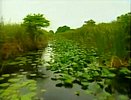 |
|
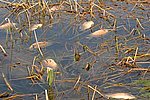 |
Fish death due to pollution effects of agricultural run-off. Water management is crucially important for Florida and its population. |
 |
|
|
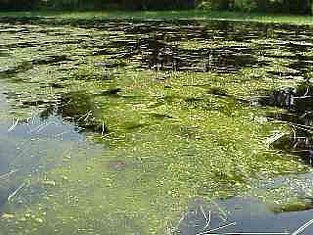
|
Visible ecological damage is demonstrated in algal blooms - due to excessive nutrient pollution (N and P) introroduced by urbanization and agriculture. Algae deplete oxygen in water, choke other life and produce toxins. The whole ecosystem is out of balance. This damage extends all the way to marine estuaries and coastal waters affecting fisheries - and tourism !
|
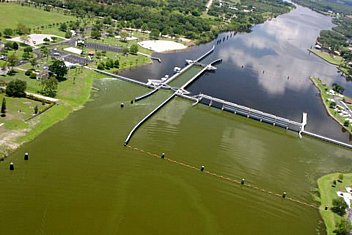 |
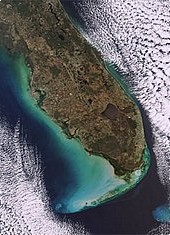
|
Nutrient pollution has become so widespread that algae bloom problems affect whole coastal areas right around the globe - to the detriment of ocean life . |
|